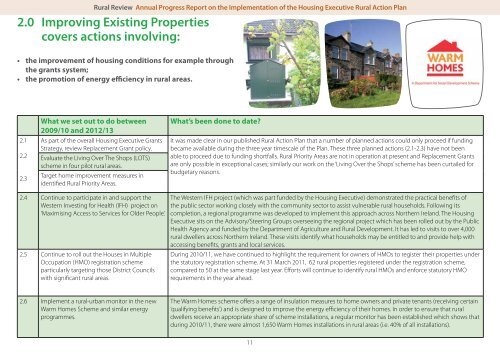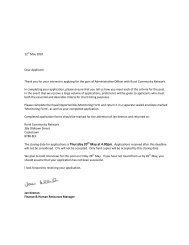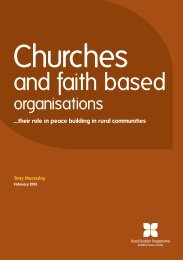Rural Review
here - Rural Community Network
here - Rural Community Network
Create successful ePaper yourself
Turn your PDF publications into a flip-book with our unique Google optimized e-Paper software.
<strong>Rural</strong> <strong>Review</strong> Annual Progress Report on the Implementation of the Housing Executive <strong>Rural</strong> Action Plan<br />
2.0 Improving Existing Properties<br />
covers actions involving:<br />
• the improvement of housing conditions for example through<br />
the grants system;<br />
• the promotion of energy efficiency in rural areas.<br />
2.1<br />
2.2<br />
2.3<br />
What we set out to do between<br />
2009/10 and 2012/13<br />
As part of the overall Housing Executive Grants<br />
Strategy, review Replacement Grant policy.<br />
Evaluate the Living Over The Shops (LOTS)<br />
scheme in four pilot rural areas.<br />
Target home improvement measures in<br />
identified <strong>Rural</strong> Priority Areas.<br />
What’s been done to date?<br />
It was made clear in our published <strong>Rural</strong> Action Plan that a number of planned actions could only proceed if funding<br />
became available during the three year timescale of the Plan. These three planned actions (2.1-2.3) have not been<br />
able to proceed due to funding shortfalls. <strong>Rural</strong> Priority Areas are not in operation at present and Replacement Grants<br />
are only possible in exceptional cases; similarly our work on the ‘Living Over the Shops’ scheme has been curtailed for<br />
budgetary reasons.<br />
2.4 Continue to participate in and support the<br />
Western Investing for Health (IFH) project on<br />
‘Maximising Access to Services for Older People’.<br />
2.5 Continue to roll out the Houses in Multiple<br />
Occupation (HMO) registration scheme<br />
particularly targeting those District Councils<br />
with significant rural areas.<br />
The Western IFH project (which was part funded by the Housing Executive) demonstrated the practical benefits of<br />
the public sector working closely with the community sector to assist vulnerable rural households. Following its<br />
completion, a regional programme was developed to implement this approach across Northern Ireland. The Housing<br />
Executive sits on the Advisory/Steering Groups overseeing the regional project which has been rolled out by the Public<br />
Health Agency and funded by the Department of Agriculture and <strong>Rural</strong> Development. It has led to visits to over 4,000<br />
rural dwellers across Northern Ireland. These visits identify what households may be entitled to and provide help with<br />
accessing benefits, grants and local services.<br />
During 2010/11, we have continued to highlight the requirement for owners of HMOs to register their properties under<br />
the statutory registration scheme. At 31 March 2011, 62 rural properties registered under the registration scheme,<br />
compared to 50 at the same stage last year. Efforts will continue to identify rural HMOs and enforce statutory HMO<br />
requirements in the year ahead.<br />
2.6 Implement a rural-urban monitor in the new<br />
Warm Homes Scheme and similar energy<br />
programmes.<br />
The Warm Homes scheme offers a range of insulation measures to home owners and private tenants (receiving certain<br />
‘qualifying benefits’) and is designed to improve the energy efficiency of their homes. In order to ensure that rural<br />
dwellers receive an appropriate share of scheme installations, a regular monitor has been established which shows that<br />
during 2010/11, there were almost 1,650 Warm Homes installations in rural areas (i.e. 40% of all installations).<br />
11








